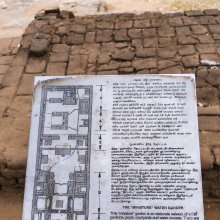Yanna, Yañña: 3 definitions
Introduction:
Yanna means something in Buddhism, Pali. If you want to know the exact meaning, history, etymology or English translation of this term then check out the descriptions on this page. Add your comment or reference to a book if you want to contribute to this summary article.
Images (photo gallery)
In Buddhism
Theravada (major branch of Buddhism)
Source: Pali Kanon: Pali Proper NamesSee Annata Kondanna. Mil. 236.
Theravāda is a major branch of Buddhism having the the Pali canon (tipitaka) as their canonical literature, which includes the vinaya-pitaka (monastic rules), the sutta-pitaka (Buddhist sermons) and the abhidhamma-pitaka (philosophy and psychology).
Languages of India and abroad
Pali-English dictionary
Source: BuddhaSasana: Concise Pali-English Dictionaryyañña : (m.) sacrifice; alms-giving.
Source: Sutta: The Pali Text Society's Pali-English DictionaryYañña, (Vedic yajña, fr. yaj: see yajati. The metric reading in the Veda is sometimes yajana, which we are inclined to look upon as not being the source of the P. yajana) 1. a brahmanic sacrifice.—2. almsgiving, charity, a gift to the Saṅgha or a bhikkhu. The brahmanic ritual of Vedic times has been given a changed and deeper meaning. Buddhism has discarded the outward and cruel form and has widened its sphere by changing its participant, its object as well as the means and ways of “offering, ” so that the yañña now consists entirely in a worthy application of a worthy gift to a worthy applicant. Thus the direct and as it were self-understood definition of yañña is at Nd2 523 given with “yañño vuccati deyyadhammo, ” and as this the 14 constituents of the latter are enumerated; consisting of the 4 paccayas, and of anna, pāna, vattha, yāna, mālā, gandhā, vilepana, seyya, avasatha, padīpeyya. Cp. Nd1 373.—The term parikkhāra, which refers to the requisites of the bhikkhu as well (see DA. I, 204—207), is also used in the meaning of “accessory instrument” concerning the brahmanic sacrifice: see D. I, 129 sq. 137 sq. They are there given as 16 parikkhāras, as follows: (4) cattāro anumati-pakkhā viz. the 4 groups khattiyas, ministers, brahmans and householders, as colleagues by consent; (8) aṭṭhaṅgāni of a king-sacrificer; (4) cattār’aṅgāni of a purohita. ‹-› The term mahāyañña refers to the brahmanic ritual (so at M. II, 204; DhsA. 145, cp. Expositor 193); its equivalent in Buddhist literature is mahādāna, for which yañña is also used at Pv. II, 950 (cp. PvA. 134). ‹-› The Jātakas are full of passages referring to the ineffectiveness and cruelty of the Brahmanic sacrifice, e.g. J. III, 518 sq.; VI, 211 sq. & cp. Fick, Sociale Gliederung, p. 146 sq. One special kind of sacrifice is the sabba-catukkayañña or the sacrifice of tetrads, where four of each kind of gifts, as elephants, horses, bulls, and even men were offered: J. I, 335; III, 44, 45; PvA. 280. The number 4 here has the meaning of evenness, completeness, or harmony, as we find it frequent in the notion of the square with ref. to Vimānas & lotus ponds (in J. Vv & Pv etc.); often also implying awfulness & magic, as attached e.g. to cross-roads. Cp. the Ep. of niraya (Purgatory) “catu-dvāra” (esp. at Pv. I, 10). See cpds. of catur.—It may also refer to the 4 quarters of the sky, as belonging to the 4 Guardians of the World (lokapālā) who were specially worth offering to, as their influence was demonic (cp. Pv. I, 4).
The prevailing meaning of yañña in the Suttapiṭaka is that of “gift, oblation to the bhikkhu, almsgiving. “ Cp. Sn. 295, 461, 484, 1043. At Vv 3426 the epithets “su-dinna, su-huta, su-yiṭṭha” are attributed to dāna.—The 3 constituents which occur under dāna & deyyadhamma as the gift, the giver and the recipient of the gift (i.e. the Saṅgha: cp. opening stanza Pv I1) are similarly enumerated under yañña (or yaññapatha) as “ye yaññaṃ (viz. cīvaraṃ etc.) esanti” those who wish for a gift, “ye yaññaṃ abhisaṅkharonti” those who get it ready, and “ye yaññaṃ denti” those who give it, at Nd2 70 (under appamatta). Similarly we find the threefold division of “yañña” (=cīvara etc.), “yaññayājaka” (=khattiyā, brāhmaṇā etc. including all 8 classes of men: see Nd2 p. 129 s. v. khattiya, quoted under janab), and “dakkhiṇeyya” (the recipient of the gift, viz. samaṇa-brāhmaṇā, kapaṇ’addhikā vanibbakā, yācakā) at Nd2 449b (under puthū).—Cp. the foll. (mixed) passages: D. I, 97, 128—144 (brahmanic criticised); II, 353, 354 (profitable and unprofitable, criticised); M. I, 82 (brahm.); S. I, 76, 160; II, 42 sq. 63, 207; III, 337; IV, 41; A. I, 166; II, 43 (nirārambhaṃ yaññaṃ upasaṅkamanti arahanto, cp. DhsA. 145); Sn. 308 (brahm.), 568 (aggihutta-mukhā yaññā: the sacrifices to Agni are the best; brahm.); Th. 1, 341; J. I, 83, 343; III, 517 (°ṃ yajati; brahm.); IV, 66; V, 491, 492; VI, 200 (yañña-kāraka-brāhmaṇa), 211 sq.; DA. I, 267; DhA. II, 6.

Pali is the language of the Tipiṭaka, which is the sacred canon of Theravāda Buddhism and contains much of the Buddha’s speech. Closeley related to Sanskrit, both languages are used interchangeably between religions.
See also (Relevant definitions)
Starts with (+4): Yanaman, Yanna pullian, Yanna Sutta, Yannabhedavada, Yannadatta, Yannagara, Yannaikkarai, Yannakala, Yannam, Yannan, Yannapatha, Yannasami, Yannasamin, Yannasampada, Yannasuttaka, Yannata, Yannavanna, Yannavarakam, Yannavarkam, Yannavarkiyam.
Ends with (+43): Abhishyanna, Abhojyanna, Akheyanna, Anukulayanna, Ayanna, Baldyanna, Barlyanna, Bhojyanna, Bhrityanna, Bhuryanna, Catukkayanna, Ceyanna, Chaplyanna, Charlyanna, Chyanna, Chyannabyanna, Cvamlyanna, Dadhyanna, Dadyanna, Dhyanna.
Full-text (+60): Yannavata, Yannupanita, Yannagara, Yanna pullian, Yannata, Yannapatha, Pariyanna, Yajin, Yannavarakam, Mucuri, Aparasaktha, Yannavanna, Yannopavita, Prakaruka, Avyaya, Yannasamin, Vainnuti, Yannakala, Yannavidhana, Yajaka.
Relevant text
Search found 29 books and stories containing Yanna, Yañña, Yaṇṇa; (plurals include: Yannas, Yaññas, Yaṇṇas). You can also click to the full overview containing English textual excerpts. Below are direct links for the most relevant articles:
Bihar and Eastern Uttar Pradesh (early history) (by Prakash Narayan)
Dana versus Yanna < [Chapter 3 - Religious Beliefs, Institutions and Practices: New Perspectives]
The Jataka tales [English], Volume 1-6 (by Robert Chalmers)
Jataka 444: Kaṇhadīpāyana-jātaka < [Volume 4]
Manusmriti with the Commentary of Medhatithi (by Ganganatha Jha)
Verse 12.37 < [Section VII - The Three Guṇas]
Verse 3.106 < [Section VII - Duties of the Householder]
Katha Upanishad with Shankara’s Commentary (by S. Sitarama Sastri)
Verse 1.1.22 < [Adyaya I, Valli I - The story of Vajasravasa]
Jivanandana of Anandaraya Makhin (Study) (by G. D. Jayalakshmi)
Classical Sanskrit literature < [Chapter 1 - Allegorical Plays in Sanskrit Literature]
The Tattvasangraha [with commentary] (by Ganganatha Jha)
Verse 2414-2417 < [Chapter 24b - Arguments against the reliability of the Veda (the Revealed Word)]
Verse 3397-3401 < [Chapter 26 - Examination of the ‘Person of Super-normal Vision’]

